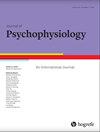慢节奏呼吸对执行功能的影响
IF 0.9
4区 心理学
Q4 NEUROSCIENCES
引用次数: 21
摘要
摘要这个实验的目的是测试慢节奏呼吸对执行功能的直接影响。慢节奏呼吸被认为会增加心脏迷走神经活动,神经-内脏整合模型预测,心脏迷走神经活动越高,执行功能越好。总共有78名参与者(41名男性,37名女性;Mage=23.22岁)参加了两种平衡的实验条件:3×5分钟慢节奏呼吸条件和电视观看控制条件。在每种情况下,测量心率变异性,参与者执行三项执行功能任务:颜色单词匹配Stroop(抑制)、自动操作跨度任务(工作记忆)和修改卡片排序任务(认知灵活性)。结果显示,与对照组相比,慢节奏呼吸后执行功能任务的表现更好,Stroop干扰准确性、自动化操作跨度得分和持续错误得分更高,但Stroop干扰反应时间没有。实验条件之间执行功能的这种差异不是由心脏迷走神经活动介导的。因此,研究结果与神经-内脏整合模型的预测仅部分一致。慢节奏呼吸似乎是一种很有前途的提高即时执行功能表现的技术。建议进行进一步的研究,以解决可能的替代潜在机制和长期影响。本文章由计算机程序翻译,如有差异,请以英文原文为准。
The Influence of Slow-Paced Breathing on Executive Function
Abstract. The aim of this experiment was to test the immediate effects of slow-paced breathing on executive function. Slow-paced breathing is suggested to increase cardiac vagal activity, and the neurovisceral integration model predicts that higher cardiac vagal activity leads to better executive functioning. In total, 78 participants (41 men, 37 women; Mage = 23.22 years) took part in two counterbalanced experimental conditions: a 3 × 5 min slow-paced breathing condition and a television viewing control condition. After each condition, heart rate variability was measured and participants performed three executive function tasks: the color-word match Stroop (inhibition), the automated operation span task (working memory), and the modified card sorting task (cognitive flexibility). Results showed that performance on executive function tasks was better after slow-paced breathing compared to control, with higher scores observed for Stroop interference accuracy, automated operation span score, and perseverative errors, but not Stroop interference reaction times. This difference in executive function between experimental conditions was not mediated by cardiac vagal activity. Therefore, findings only partially align with predictions of the neurovisceral integration model. Slow-paced breathing appears a promising technique to improve immediate executive function performance. Further studies are recommended that address possible alternative underlying mechanisms and long-term effects.
求助全文
通过发布文献求助,成功后即可免费获取论文全文。
去求助
来源期刊

Journal of Psychophysiology
医学-神经科学
CiteScore
2.60
自引率
7.70%
发文量
25
审稿时长
>12 weeks
期刊介绍:
The Journal of Psychophysiology is an international periodical that presents original research in all fields employing psychophysiological measures on human subjects. Contributions are published from psychology, physiology, clinical psychology, psychiatry, neurosciences, and pharmacology. Communications on new psychophysiological methods are presented as well. Space is also allocated for letters to the editor and book reviews. Occasional special issues are devoted to important current issues in psychophysiology.
 求助内容:
求助内容: 应助结果提醒方式:
应助结果提醒方式:


